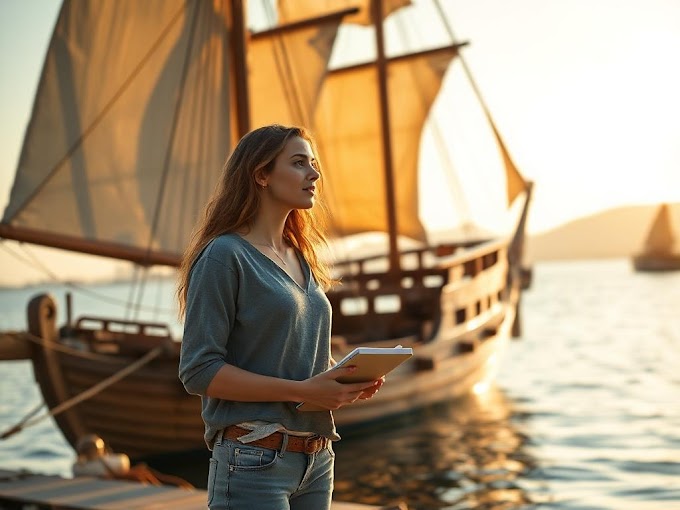Ship technology is something outstanding in human history. Beyond merely being a tool for navigating and trading, it showed that technology was really and significantly connected with nature. For today, at such times when climate change is alarming and natural resources are running down to their minimum capacity due to environmental crises, ship technology can be studied profoundly from ancient times. This ancient knowledge is not only a chapter of the past but can also play an important role in solving modern problems. In today's discussion, we will explore this topic in depth.
Wind power : From ancient sails to modern wind turbines
When ancient sailors sailed the seas, their main power was
the wind. The Dutch Flying Dutchman, the British clipper, and the Arabian dhow
were shining examples of the use of wind power. With the help of wind they
could cover thousands of kilometre’s in a short time.
Today, this wind power has become an important source of
environmentally friendly transportation and reducing fuel costs. Technologies
such as the current "Wind Challenger Project" are being inspired by
ancient ships and applied to modern ships.
Modern examples:
Solar and wind hybrid technology on cargo ships.
Reused sails in fuel-efficient ships.
Wind turbines as a green energy source.
Wooden shipbuilding : sustainable and environmentally friendly solutions
In ancient times, wood was the primary material from which
ships were made. It was strong, easily accessible and environmentally friendly.
For example, Viking longships and Japanese wooden ships.
Today, ancient wooden ship technology has become an example
for the use of recyclable materials in shipbuilding. Instead of steel and
aluminum, ships can be lighter and stronger by using wood.
Examples:
Eco-friendly ships using recycled wood.
Modern yachts
made of a combination of wood and carbon fiber.
Using traditional wooden technology with a sustainable future for the shipbuilding.
Floating cities inspired by the Venice example
The whole Venice city in Italy is based totally on water as
it gives a perfect sense of structure of architecture, naval technique, and
history.
At the same time, when coastal zones become flooded with
rising sea levels, a floating city can play an important role in solving this
problem. By analogy with Venice, technologies for permanent floating dwelling
construction and building construction are created.
Examples:
Floating urban development project in the Maldives.
Floating houses and farmland in the Netherlands.
Sustainable Water City Project in Japan.
Catamaran Design : A Symbol of Speed and Stability
Ancient Polynesian vessels, known as catamarans, were one of
the greatest examples of increased stability and speed in sailing. Made up of
two floating structures, this vessel was very effective for sailing at sea.
Nowadays, the design of catamarans is applied in the
construction of modern vessels, which includes ferries, passenger ships, and
luxurious yachts. It is also highly popular due to its high energy efficiency
and environmentally friendly performance.
Modern examples:
Electric catamarans.
High-speed ferry services.
Environmentally friendly yachts in tourism sector.
Waterproof structures : From ancient designs to modern architecture
The curved forms and waterproof designs of the ancient ships
have played an essential role in modern architecture. It is inspired by this
kind of design while building a structure in the sea or coastal areas.
Example:
Water Resistant Museum of Norway.
Houseboat technology in Japan.
Construction of hurricane and flood resistant buildings.
Water-saving and purification technology
Ancient mariners had less water supply. So they used water
purification technology. It is the ancestor of present desalination plants.
Present use:
Fresh water is prepared from salt water through purification
technology of sea water.
Less cost improved water saving system.
Source of drinking water during natural calamity.
Fossil-free navigation
Ancient vessels are powered with wind and tidal forces.
These ideas today are opening up new ways of applying renewable energy and
green energy.
Example:
Solar and wind powered ships.
Hybrid ships, running on a combination of wind and solar
energy.
Energy-efficient boats for sustainable maritime tourism.
Military Tactics : Ancient to Modern Naval Warfare
Ancient military ships, like the Roman trireme, their
designs and combat tactics are also relevant to today's modern navies. Improved
versions of ancient technology are being used for faster speed and stability in
naval warfare.
Modern examples:
Underwater drone technology.
Smart missile systems.
Advanced designs of war ships.
Supersonic vessels : Ancient to modern designs
Ancient sailors employed unique designs to enhance the speed
of their ships. Modern versions of these ideas are employed in supersonic
vessels.
Examples:
Hydrofoil technology.
Fast passenger ferries.
High-speed racing boats.
Seaborne trade revival
In ancient times, the main means of trade was the sea. In
modern times, this concept is re-popularized to reduce carbon emissions in the
transportation sector.
Examples:
Re-use of wind and solar energy in cargo shipping.
Eco-efficient waterways for transporting e-commerce
products.
Cheap and environmentally friendly trade routes in
developing countries.
Unconventional Ship Technology : Lessons from Archaeological Discoveries
Ancient shipwrecks in the depths of the ocean are giving us
new information. These discoveries are opening up new aspects of ancient ship
construction and technology.
Examples:
Learning from the wreck of the Titanic.
Ancient solar barque discovery in Egypt.
Reconstruction of a Greek trireme.
Conclusion
Ancient ship technology is not just part of history but also
an important source for solving modern problems. This ancient technology can be
used to inspire climate change, sustainable development, and technological
innovation.
We must look back to our ancient traditions and knowledge
today, because, dependent on modern technology as we are, this knowledge will
not only connect us with the past but will also help us build a sustainable and
better world for the future.
















0 Comments